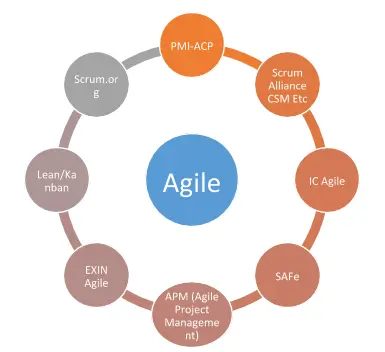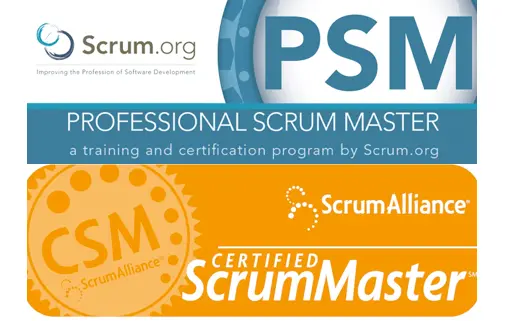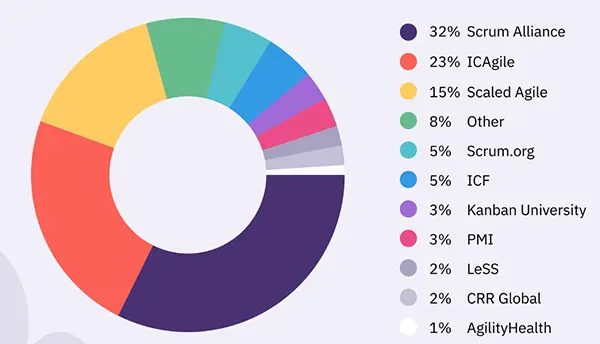We are in the dynamic domain of Agile project management where Scrum Master’s job is to facilitate communication, encourage teamwork, and lead teams to success.
CSM Certification programs are often pursued by aspiring Scrum Masters in order to start this Agile journey and verify their expertise.
This article examines credible certifying bodies, training courses, and the value of certification in the workplace in order to investigate where people can become certified as Scrum Masters.
Obtaining a SAFe Agile certification, which goes beyond Scrum Master certification, is a significant step forward in one’s Nimble journey.
SAFe Agile certification prepares experts to scale quick concepts for big businesses, as well as to provide a disciplined approach to active transformations.
This dual certification increases adaptability and qualifies individuals as competent leaders in both Scrum and larger nimble frameworks.
The Scrum Master Certification Landscape:

These are provided by a number of organizations, each with its own curriculum, testing procedure, and recognition.
Within the Agile community, the most reputable and widely recognized certifications are usually associated with well-established certifying bodies. Let’s examine a few of the well-known ones:
- Simplilearn
- Certification Offered: Certified ScrumMaster (CSM), Certified Scrum Product Owner (CSPO), Professional ScrumMaster, PMI ACP Certification, Professional Scrum Product Owner, SAFe Certification: Leading SAFe® 6 Training with SAFe Agile Certification.
Do You Know?:
The Scrum Framework is utilized by 66% of Agile Businesses.
- Instructional Format: Live or recorded instructor-led instruction with learner assistance
After cracking the examination, advanced certification options are also available.
- Scrum Alliance:
- Certification Offered: Certified ScrumMaster (CSM)
- Overview: The Certified ScrumMaster (CSM) credential is offered by the Scrum Alliance, a leading organization in quick certifications.
The core ideas of it are team dynamics, and the responsibilities of a Scrum Master are all covered in this training course.
To solidify their understanding, participants take part in discussions and hands-on activities.
- Instructional Format: Live or recorded instructor-led instruction.
- Exam: There isn’t a formal exam; the main requirements are to complete the training and engage in class activities.
- Renewal: Via Scrum Education Units (SEUs), every two years.
- Scrum.org:

Professional Scrum Master I (PSM I), Professional Scrum Master II (PSM II), and Professional Scrum Master III (PSM III) certifications are available.
- Synopsis: Ken Schwaber, a co-creator of Scrum, founded Scrum.org, which provides a range of professional certifications at different skill levels.
When PSM II and PSM III evaluate more advanced Scrum Master competencies, PSM I is foundational.
- Training Format: While not required, training is advised. For certification, there are online exams available.

Statistics:
The pie chart above indicates Scrum Alliance as the most popular agile certification body with 32% of the majority.
- Exam: Strict online tests are required for every certification level.
- Renewal: There is no official process; certification is perpetual.
- Project Management Institute (PMI):
PMI Agile Certified Practitioner (PMIACP) certification is available.
- Overview: The PMI Agile Certified Practitioner (PMIACP) credential is provided by PMI, which is well-known for its Project Management Professional (PMP) certification.
This certification certifies a practitioner’s expertise in quick project management and covers a variety of Nimble approaches, such as Scrum.
- Training Format: Providers approved by PMI offer in-person or remote instruction.
- Exam: Multiple-choice questions covering Scrum and other nimble practices and principles.
- Renewal: Via Professional Development Units (PDUs), every three years.
- Scaled Agile, Inc.:
- Overview: SAFe® 5 Scrum Master Certification is available. A thorough Agile framework designed for large businesses is called a Scaled Agile Framework (SAFe).
Its functions in a SAFe environment is the main topic of the SAFe Scrum Master certification.
It covers the values, procedures, and resources needed to become a productive Master in environments with scaled Agile.
- Training Format: SAFe Program Consultants offer instructor-led training.
- Exam: After training is over, there will be an online exam.
- Renewal: Each year with an annual renewal fee and through continuing education.
Choosing the Right Certification Path
Various factors, such as career goals, preferred learning styles, and the specific Agile methodologies used within an organization, must be taken into consideration when choosing the best certification path.
To select the appropriate certification, keep the following factors in mind:
Alignment with Organizational Needs
Think about the frameworks and techniques that are applied in your company.
When some certifications, like CSM or PSM, are more broadly applicable, others, like SAFe Scrum Master, are tailored to particular frameworks.
Career Goals
Evaluate your long-term professional objectives in the Agile field.
Interesting Fact:
The name “Scrum” began as a term in Rugby which basically describes a team that organizes itself and begins moving down the field together, as one.
Certifications like SAFe Scrum Master may be especially great if you are committed to working in scaled environments or if you are focused on a particular framework.
Training Preferences
Analyze the learning format that you prefer.
While some certifications, like PSM, allow for the flexibility of self-study using online resources, others, like CSM or SAFe Scrum Master, require instructor-led training.
Industry Recognition
Think about the standing and acceptance of certifying organizations in the community.
In general, certifications from reputable organizations like Scaled Agile, Scrum Alliance, and Scrum.org are highly valued.
Depth of Knowledge
Determine how much expertise level you wanna crack. Scrum.org offers certifications such as PSM II and PSM III that are designed for individuals who want to go beyond the foundational level of proficiency.
The Significance of Scrum Master Certification:
Acquiring it provides numerous benefits in the workplace:
1. Increased Credibility: Becoming certified attests to your grasp of methodologies, principles, and the role, which raises your stature as an accomplished practitioner.
2. Global Recognition: Accreditation from respectable organizations such as Scrum Alliance and Scrum.org offers a uniform gauge of Agile proficiency that is accepted throughout the world.
3. Career Advancement: Obtaining a certification can lead to new prospects and professional growth by demonstrating to potential employers that you have the abilities needed for efficient Agile project management.
Do You Know?:
When people were asked about their previous roles before becoming Scrum Masters, 31% of them said they were “Project Managers”, 25% were “Software Developers”, 9% were “Business Analysts”, and 8% of them were “QA”.
4. Skill Validation: A certification verifies your ability to implement principles in practical settings and shows your dedication to lifelong learning.
5. Community Engagement: Obtaining certification frequently entails becoming a member of a practitioner community, which offers chances for networking, knowledge exchange, and continued professional growth.
Conclusion:
A key milestone in an Agile journey is earning a Scrum Master certification, and the program of choice can have a big impact on learning outcomes and career paths.
Choosing between the certification path provides a special combination of knowledge, real-world experience, and industry recognition.
To begin a fulfilling and influential Agile career as a certified Scrum Master, you must match your decision with organizational needs, career goals, and preferred learning styles.